Summary of climate disasters on the planet: April 9–15, 2025
The natural anomalies of the past week from April 9 to 15 serve as yet another reminder that the familiar patterns of our world are fracturing.
Where it should already be warm, snowstorms rage. Where it’s usually cool, summer-like heat prevails.
Hurricane winds are destroying cities, people are suffocating from dust storms, and crops are perishing due to sudden frosts.
Destroyed homes, hundreds of fatalities, and millions affected.
Read the full details below.
China
Starting April 10, China faced an unprecedented onslaught of extreme weather. Massive storms unleashed powerful winds, sandstorms, torrential rains, and hail over a vast swath of the country.
More than half of China's provinces and regions were affected by the disasters.
The northern part of the country bore the brunt of the catastrophe. Nearly 500 meteorological stations across the country recorded record-breaking wind speeds for April.
The provinces of Hebei and Henan suffered the most severe damage. Wind speeds here reached Force 15 on the extended Beaufort scale, equivalent to 46.2–50.9 meters per second (103–114 mph).
Chaos reigned in cities: roofs were torn off, window frames were ripped out of buildings, and streets were littered with debris, downed power lines, shattered glass, and other wreckage.
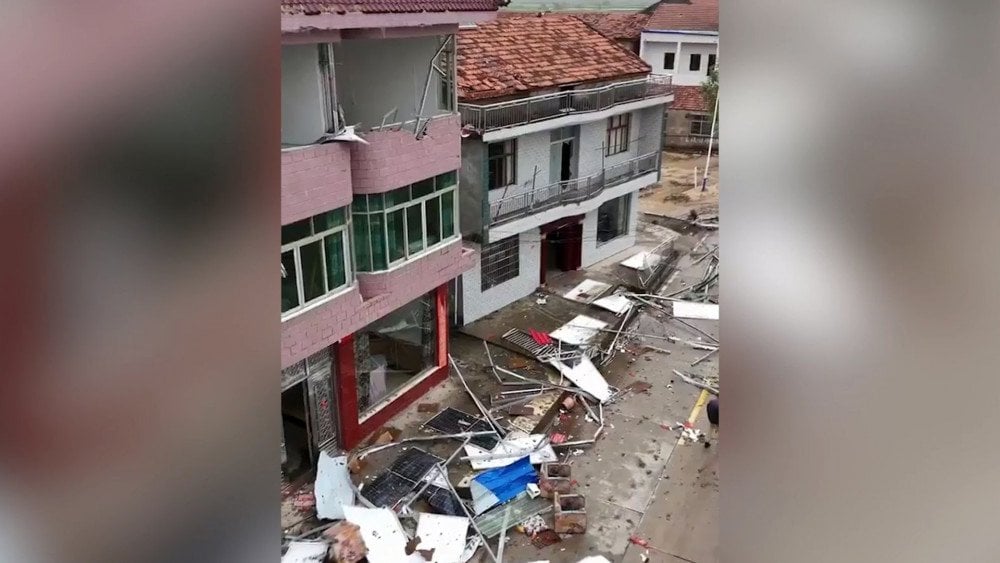
Storm winds of unimaginable force caused large-scale chaos and destruction in China
In Beijing, at the high-altitude Mencheng Alpine Rose Garden meteorological station in Mentougou District, gusts reached a maximum speed of 45.8 meters per second or 102 mph (force 14 on the extended Beaufort scale), comparable to a Category 2 hurricane.
More than 800 large trees were toppled in the city and hundreds of cars were damaged. Residents weighing less than 50 kilograms (110 pounds) were advised to stay indoors to avoid being blown away by the wind.
The storm paralyzed transportation networks across the country. Over 3,200 flights were canceled nationwide, and train services, including high-speed rail lines, were suspended.
The powerful winds also triggered sandstorms. Regions including Inner Mongolia, Xinjiang, Ningxia, and Gansu were shrouded in a dense yellow haze of sand that blanketed the sky. Visibility dropped to critically low levels, while the concentration of sand and dust in the air reached hazardous levels. Eyewitnesses reported that people had to sleep wearing masks.
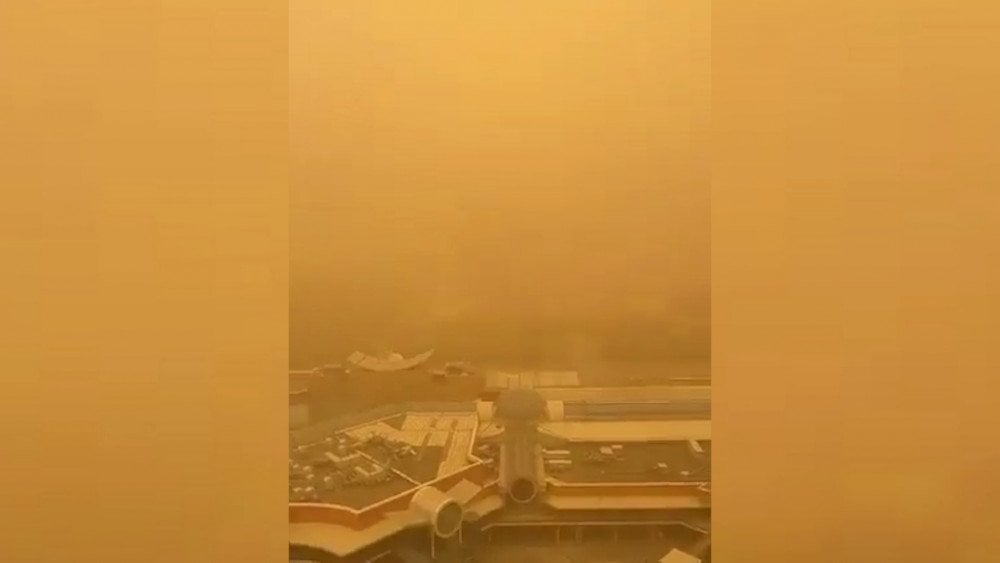
Sandstorm enveloped regions of China in a thick yellow shroud
The storm spread rapidly to southern and eastern China, bringing its destructive force to these areas as well.
In Anhui province, a falling tree struck a woman riding an electric bicycle. Tragically, she succumbed to her injuries.
In the city of Nanjing, Jiangsu province, sudden large hailstorms caused significant damage to vehicles, infrastructure, and agricultural land.
In Nanchang County, Jiangxi province, air quality levels during a dust storm dropped to 1,240 µg/m³. This is 82 times the World Health Organization’s recommended daily average of 15 µg/m³—an exceedingly rare occurrence for the region.
South Korea
Under the influence of a cyclone that came from the north, weather conditions in South Korea suddenly changed. On April 12, temperatures in many regions still reached nearly +25 °C (+77 °F), but by the next day, there was a sharp cold snap. In Seoul, morning temperatures dropped to +1.1 °C (+34 °F), and due to strong winds, the perceived temperature fell to −2.4 °C (27.7 °F).
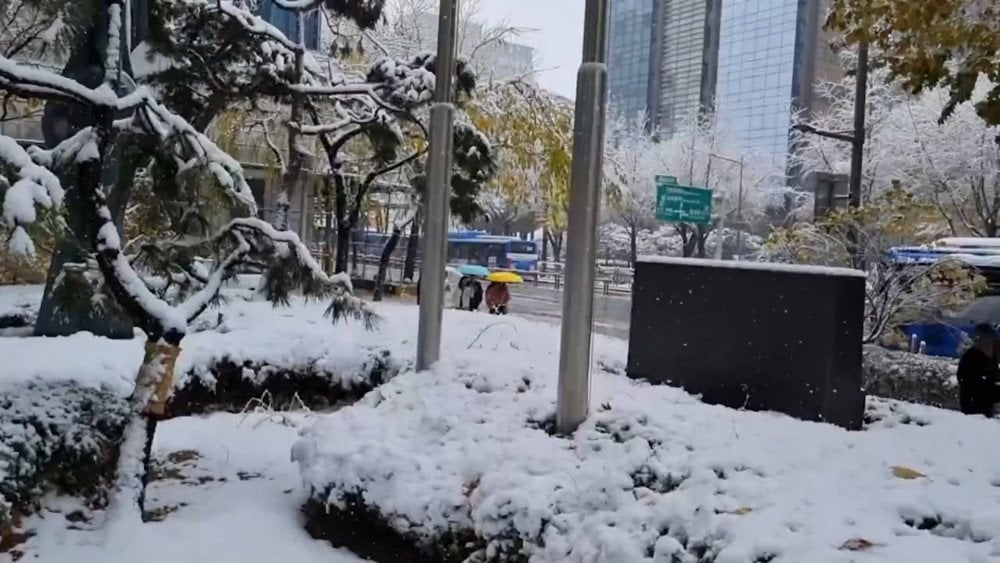
Snow in april—a rare and shocking phenomenon for Seoul, South Korea
The capital region also found itself in an area of high dust concentration, brought by winds from the deserts of China and Mongolia.
But the most shocking event for residents of Seoul was the snow that fell in the Seongdong District so late—in mid-April. From the evening of April 12 to the morning of April 13, up to 0.6 cm (0.24 in) of snow fell. This was the first time such an event had occurred in 118 years of meteorological observations.
In addition to cold air, rain, and snow, the cyclone brought winds reaching 30 m/s (67 mph) to the cities of Yeosu, Yangyang, Busan, and Hwaseong. It uprooted trees and tore down billboards, posing significant risks to pedestrians and vehicles.
Russia
On April 13, severe weather also struck Primorsky Krai.
The hardest-hit areas were Khasansky District, the cities of Nakhodka and Fokino, and the village of Chuguyevka. In Lazovsky District, up to 44 mm (1.73 in) of precipitation fell within 12 hours. However, the main damage was caused by hurricane-force winds, which reached speeds of 29 m/s (65 mph) in Vladivostok and up to 39 m/s (87 mph) at the capes of Peter the Great Gulf. The winds tore off roofs, broke fences, uprooted trees and knocked down road signs. Building facades were damaged. About 9,000 residents of the region were left without power.
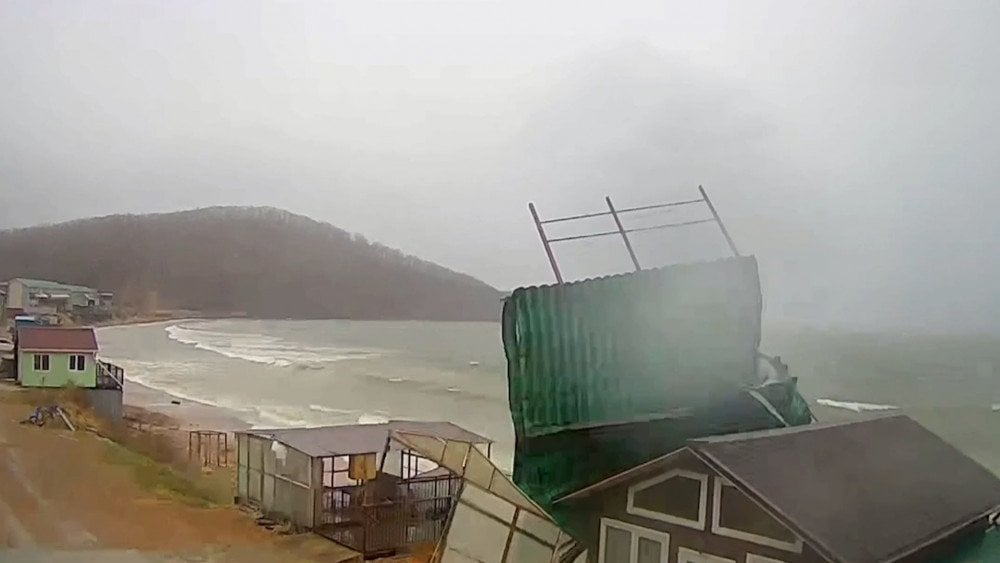
Strong storm winds destroy structures, Primorsky Krai, Russia
For the second time this year, Siberia has experienced unseasonal, abnormally hot weather. From April 12 to 14, numerous temperature records were broken in the southern part of the region—some for the first time in decades.
In the village of Chemal, daily records were set: April 12—Tmax = +30.5 °C (+86.9 °F); on April 13, the air warmed up to an unprecedented +31.7 °C (+89.1 °F), nearly 22 degrees above the norm; April 14—Tmax = +28.5 °C (+83.3 °F).
For the first time in recorded history, 30-degree heat was observed this early in Siberia— in the first half of April.
It was abnormally warm even at night. For example, in Omsk on April 11 and 12, instead of the usual subzero temperatures (−1 °C / 30.2 °F), it was +13.2 °C (+55.8 °F) and +12.6 °C (+54.7 °F), respectively.
On April 12 and 13, in Novosibirsk, daily heat records were broken — the air warmed up to +26 °C (+78.8 °F) and +23.2 °C (+73.8 °F), respectively, although in April temperatures usually do not exceed +8 °C (+46.4 °F). It is worth noting that since the end of March, air temperatures here have consistently exceeded climate norms.
In the city of Abakan, on April 14, the daily record was exceeded by 6.5 degrees: the temperature reached +28.9 °C (+84 °F) (the previous daily record of +22.4 °C (+72.3 °F) was set in 2008).
People, surprised by such a natural anomaly, were taking photos in T-shirts and shorts against the backdrop of still bare trees and ice-covered water bodies.
At the same time, the southern parts of the country experienced abnormally cold weather. After a nearly summer-like March, when in Krasnodar Krai, Stavropol Krai, and Adygea temperatures reached +20 °C (+68 °F), frosts and snowfalls suddenly returned. In some areas of the Republic of Adygea, snow depth reached 36 cm (14.2 in). This is an incredible phenomenon for these regions.
Unexpected frosts that hit the south and central parts of Russia caused significant damage to agriculture. According to estimates from the Union of Gardeners of Russia, crop losses of apricots, peaches, and cherries may reach up to 40%.

Unexpected snow fell in Stavropol Krai after a warm March, Russia
Tajikistan
On April 13 at 09:24 LT, an earthquake with a magnitude of 5.9 struck the Rasht District of Tajikistan, 160 km (99 mi) northeast of the city of Dushanbe. According to the Committee for Emergency Situations, hundreds of structures were damaged, and 94 residential houses were completely destroyed.

Destroyed building—aftermath of the M5.9 earthquake in the rasht district of Tajikistan
Tragically, a three-year-old child died after being buried under the rubble of a house wall.
Over the next 24 hours, four aftershocks with magnitudes above 3 were recorded.
The earthquake was also felt in neighboring countries: Uzbekistan, Kyrgyzstan, and Kazakhstan.
Turkey
A powerful cold front caused a sharp drop in temperatures, snowfalls, and severe storms in at least 25 provinces across the country.
In the city of Aksaray, located in the Central Anatolia region, temperatures fell from +26 °C (+78.8 °F) to –3 °C (26.6 °F) within a few days.
Istanbul bore the brunt of the storm's impact. The storm tore roofs off buildings and uprooted trees. A sudden wind shift created dangerous conditions, forcing planes at both of the city's airports to delay landings, risking emergency situations due to fuel shortages.
The country’s capital, Ankara, was covered overnight with a layer of snow, and wind speeds there reached 60 km/h (37 mph).
Snowfalls affected central and western Anatolia. In the Ağlı district, Kastamonu Province, on April 13, snow depth exceeded 50 cm (19.7 in), and in mountain villages it approached 80 cm (31.5 in). Cars were stuck in the snow, and transportation in the province was paralyzed.
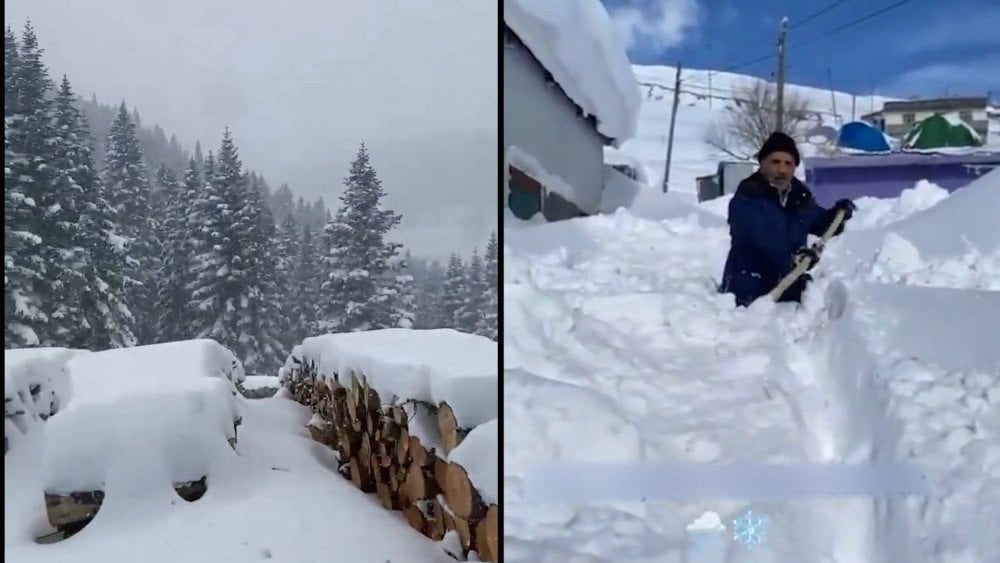
Heavy snowfalls hit Turkey
Key agricultural regions of the country were badly affected. From April 10 to 12, temperatures in some areas dropped to −15 °C (5 °F).
According to the Ministry of Agriculture, the country experienced some of the most devastating frosts in its history.
Hazelnuts, Turkey’s main export product, were particularly hard hit—bringing in about 2 billion dollars annually. It is worth noting that Turkey is the world’s largest producer of hazelnuts, accounting for three-quarters of global production.
In Malatya Province, frosts caused serious damage to apricot plantations—losses are estimated at hundreds of millions of dollars. In Manisa, more than 75% of vineyards were damaged. Walnuts, almonds, sunflowers, potatoes, and ornamental plants were also affected.

Snow and frosts in Turkey: devastating aftermath for fruit orchards
India
The northern states of India—Uttar Pradesh, Bihar, and Jharkhand—faced the tragic aftermath of deadly storms.
As of April 12, in just one day, at least 102 people died due to torrential rains, flooding, and lightning strikes.

Aftermath of deadly storm in India
The highest number of casualties was recorded in the state of Bihar, where the disaster claimed the lives of 82 people. Due to an inadequate disaster warning system, the alert about the approaching storm did not reach residents of rural areas, and the storm struck while they were working in the fields. Sadly, this led to such a high number of victims. The disaster caused serious damage to the energy sector and infrastructure of the states.
Starting April 11, storms and a dust storm in Delhi caused flight cancellations and delays at Indira Gandhi International Airport, leaving thousands of passengers stranded.
The powerful storm also caused chaos in neighboring Nepal. According to the National Disaster Risk Reduction and Management Authority of Nepal, at least eight people died due to lightning strikes and torrential rains.
Iraq
On April 14, the southern and central regions of the country were covered by a powerful dust storm that had formed in northern Saudi Arabia. The provinces of Basra, Muthanna, and Maysan were the hardest hit.
Day turned into night, and in some places visibility dropped to zero. This led to road traffic accidents and the suspension of operations at international airports in the cities of Baghdad, Basra, and Najaf.

Iraq engulfed by powerful dust storm, visibility near zero
However, the dust storm had its greatest impact on people's health. Within a day, more than 3,700 people sought medical help with symptoms of suffocation. Many of them, including children, were hospitalized. The disaster also affected neighboring countries — Iran and Kuwait. In some areas of Iran’s Khuzestan Province, on April 15, the concentration of airborne pollutants up to 10 µm in size exceeded the permissible limit by 67 times. In Kuwait, wind gusts exceeding 80 km/h (50 mph) were recorded, leading to power outages in several parts of the country.
Today, despite more and more people are personally witnessing the intensifying natural disasters and anomalies, disinformation continues to be spread through the media space. The media do not explain the real causes of the growing natural disasters. They do not show us important facts. And most importantly — they stay silent about the fact that a solution already exists that could stop the escalating disasters and prevent the worst-case scenario.
Instead, they lull us with phrases like: “This has happened before,” “Everything is still within the normal range,” “There’s nothing to worry about.”
In the past, such nonsense could be simply ignored. But not today!
Today, the price is too high, because it is about the future of all humanity.
Why, seeing what is happening, do so many people continue to believe in fairy tales?
Do they really think this won’t affect them? Do they think they live on another planet?
After all, everyone has loved ones—families and children. A reasonable person, having learned about a threat, passes the information on and seeks a solution. If we want to protect life on Earth, we must speak up about the real danger: global geological and climate changes, and the processes occurring in the Earth’s interior.
Many people feel powerless — as if nothing depends on them. But that’s not true.
The lives of billions of people, including the lives of those we love the most, depend on each one of us.
You can watch the video version of this article here:
Leave a comment